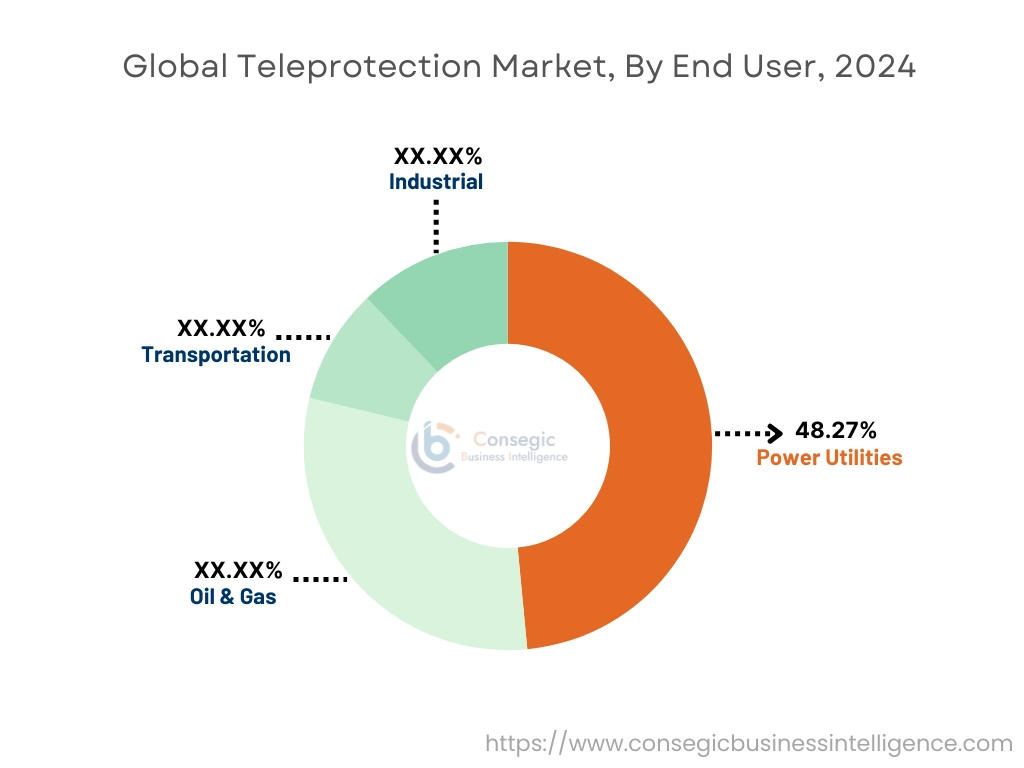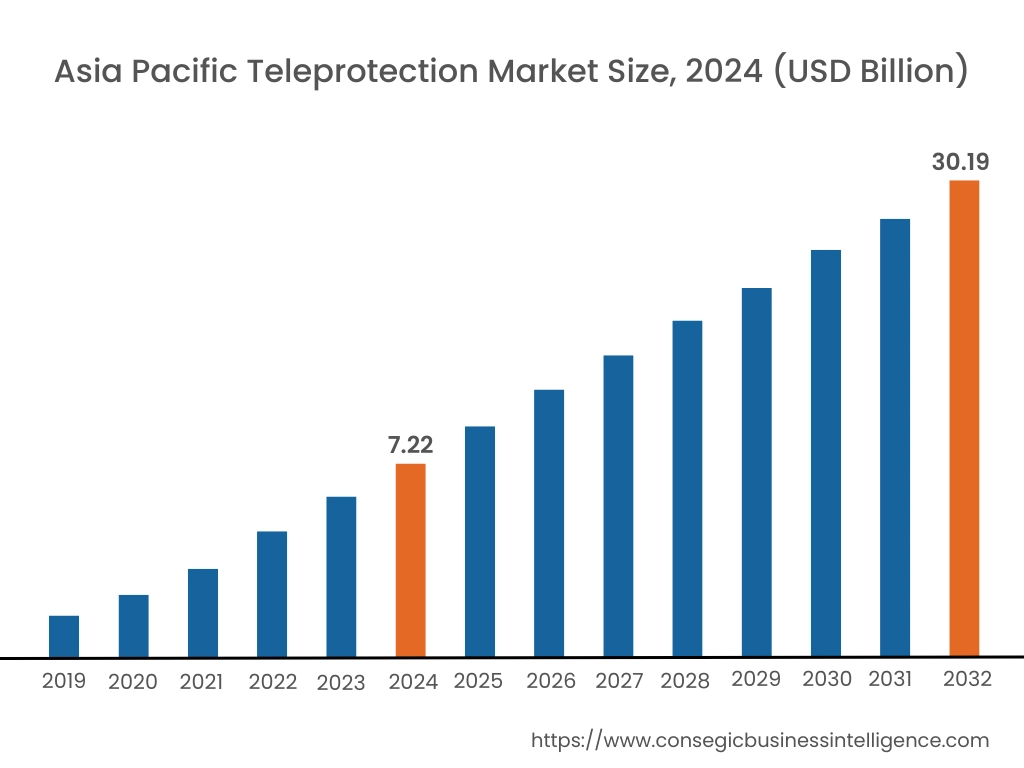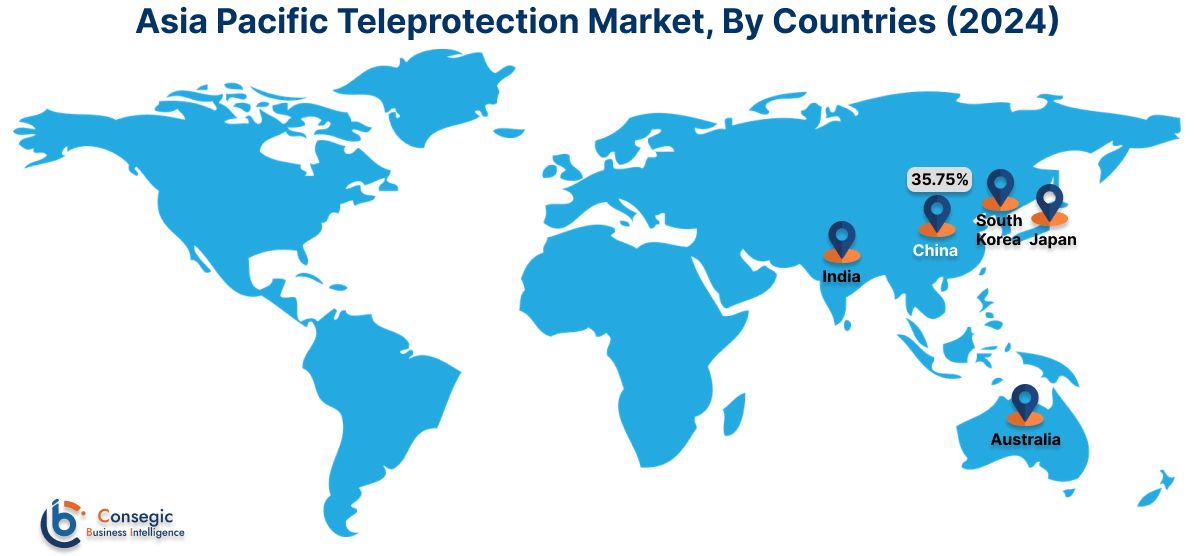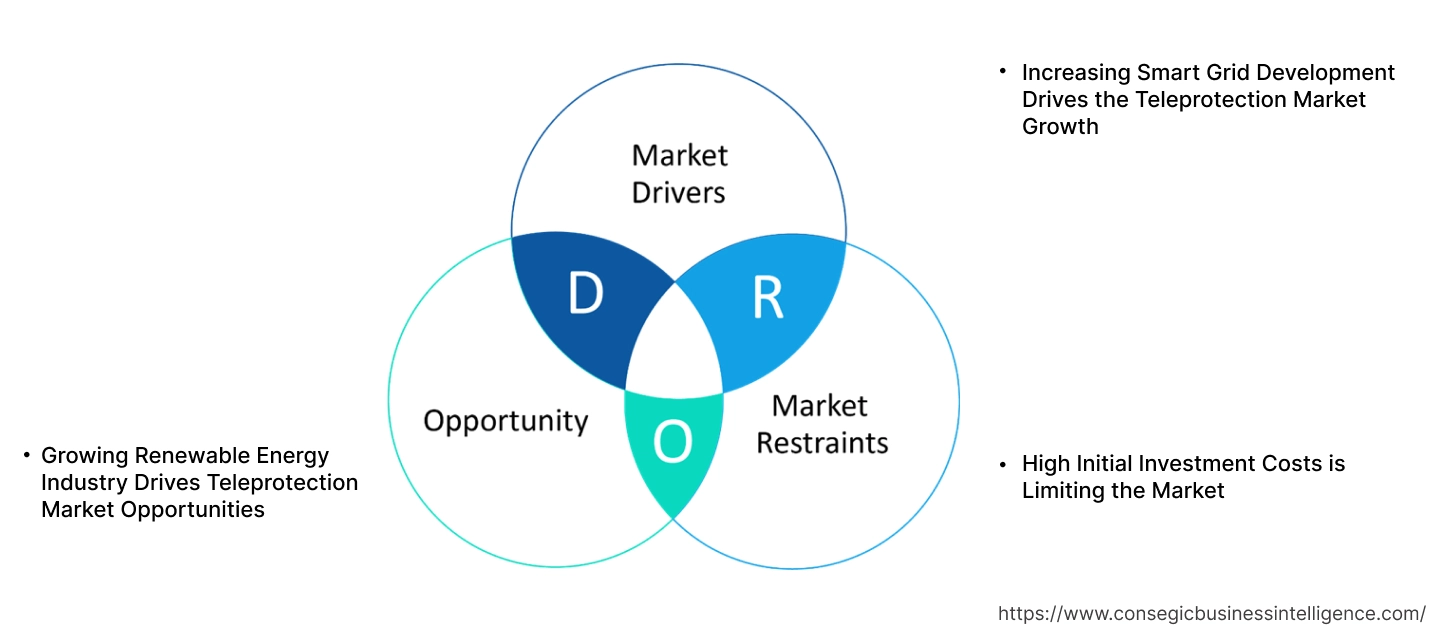- Summary
- Table Of Content
- Methodology
Teleprotection Market Size:
Teleprotection Market is estimated to reach over USD 109.63 Billion by 2032 from a value of USD 27.29 Billion in 2024 and is projected to grow by USD 31.99 Billion in 2025, growing at a CAGR of 21.3% from 2025 to 2032.
Teleprotection Market Scope & Overview:
Teleprotection is the use of communication channels to transmit protection signals between substations in a power system. It enables fast and coordinated tripping of circuit breakers to isolate faults quickly, minimizing damage and maintaining system stability. Further, benefits including enhanced grid reliability, faster fault isolation, minimized equipment damage, improved power system stability, and reduced outage times are driving the market. Furthermore, key factors driving the market include advancements in communication technologies, increasing adoption of the IEC 61850 standard, demand for secure communication systems, and grid modernization.
Key Drivers:
Increasing Smart Grid Development Drives the Teleprotection Market Growth
Smart grid development is a significant driver for the market's growth. As power grids modernize to become smarter, they incorporate advanced communication technologies, automation, and control systems for enhanced efficiency, reliability, and security. This increasing complexity and interconnectedness of smart grids necessitates sophisticated systems. Further, the technology ensures the fast and reliable exchange of critical signals between substations and control centers, enabling swift fault detection and isolation. This is crucial for maintaining grid stability, preventing widespread blackouts, and minimizing damage to equipment.
- For instance, in 2022 European Commission launched "digitalization of the energy system" plan with a total investment of around USD 633 billion to modernize the Europe's electricity grid by 2030. Further, a significant portion, USD 184 billion is allocated to digital upgrades like smart meters and automated grid management.
Thus, increasing smart grid development contributes significantly to the teleprotection market size.
Key Restraints:
High Initial Investment Costs is Limiting the Market
High initial investment costs pose a significant barrier to the widespread adoption of the system. Implementing sophisticated communication infrastructure, specialized hardware, and software requires substantial upfront capital expenditure. This can be particularly challenging for smaller utilities, developing economies, and smaller organizations. Further, the cost sensitivity can slow down market growth, especially in regions where grid modernization efforts are still in their early stages and funding availability is limited.
Future Opportunities :
Growing Renewable Energy Industry Drives Teleprotection Market Opportunities
The growing renewable energy industry significantly drives the market. Integrating renewable sources like solar and wind power into the grid introduces complexities in maintaining grid stability and reliability. Teleprotection systems are crucial for rapidly detecting and isolating faults that may arise due to the variable nature of renewable energy generation. These systems enable seamless integration by facilitating quick communication and control between substations and control centers, ensuring grid operators can effectively manage the fluctuating power flows from renewable sources.
- For instance, according to IEA, by the end of the current decade, worldwide electricity generated from renewable sources is projected to rise to over 17,000 TWh, marking an almost 90% growth from 2023 figures.
Thus, need for enhanced grid stability with increasing renewable penetration drives the teleprotection market opportunities.
Teleprotection Market Segmental Analysis :
By Component:
Based on the component, the market is segmented into protection relays, trip circuits and circuit breakers, test and monitoring equipment, Supervisory Control and Data Acquisition (SCADA), and backup and redundancy systems.
Trends in the Component:
- Increasing demand for advanced circuit breaker technologies such as vacuum circuit breakers and SF6-free circuit breakers is driving the teleprotection market trends.
- Increasing incorporation of sensors and monitoring capabilities within trip circuits and circuit breakers is expected to drive teleprotection market size.
Protection relays accounted for the largest revenue share in the year 2024.
- Increasing adoption of digital and numerical relays for faster response times and enhanced accuracy is driving the teleprotection market share.
- Further, there is an increasing trend of embedding robust cybersecurity protocols within the relay design to protect against cyber threats.
- Furthermore, increasing adoption and integration of the IEC 61850 communication standard for substation automation which in turn drives the teleprotection market trends.
- For instance, in February 2023, ABB launched a new Relay Retrofit Program to modernize power protection and control systems by replacing older SPACOM relays with their latest REX610 technology.
- Thus, as per teleprotection market analysis, digital and numerical relays, integration of cybersecurity features, and support for IEC 61850 standard are driving the market.
Supervisory Control and Data Acquisition (SCADA) is anticipated to register the fastest CAGR during the forecast period.
- There is a growing demand for SCADA systems to provide real-time visibility of protection system status, alarms, and events which in turn drives the teleprotection market share.
- Further, growing use of SCADA for providing insights into system reliability, identifying potential issues, and offering customized dashboards for better visualization which in turn drives the teleprotection market demand.
- Furthermore, growing adoption of cloud computing for SCADA systems, offering benefits like remote access, scalability, and cost-effectiveness.
- Therefore, enhanced integration, real-time data analytics, and cloud-based solutions are anticipated to boost the market during the forecast period.
By Communication Type:
Based on the communication type, the market is segmented into wired and wireless.
Trends in the Communication Type:
- Growing focus on developing and implementing robust and secure wireless communication protocols specifically tailored for teleprotection applications which in turn drives the teleprotection market demand.
Wired accounted for the largest revenue share in the year 2024.
- Growing adoption of fiber optic cables due to their high bandwidth, low latency, immunity to electromagnetic interference, and secure data transmission.
- Further, focus on modernizing existing copper-based communication infrastructure with technologies like DSL and Ethernet to improve bandwidth and reliability in turn drives the market.
- Furthermore, implementation of advanced security protocols and physical security measures for wired communication infrastructure.
- Thus, as per teleprotection market analysis, adoption of fiber optic networks, modernization of existing copper infrastructure, and enhanced security measures are driving the market.
Wireless is anticipated to register the fastest CAGR during the forecast period.
- Growing technological advancements in wireless technologies are expected to drive the market.
- Further, utilizing satellite communication as a backup communication channel or for providing protection in extremely remote locations propels the teleprotection market expansion.
- Therefore, based on analysis, growing use of microwave communication and satellite communication are anticipated to boost the growth of the market during the forecast period.
By Application:
Based on the application, the market is segmented into transmission lines, distribution networks, traffic management, and others.
Trends in the Application:
- Growing implementation of technology for monitoring the integrity of pipelines and triggering safety shutdowns in case of leaks, pressure anomalies, or other critical events.
- Growing adoption of technology in large industrial facilities to protect critical equipment and processes from electrical faults is expected to drive the market.
Transmission lines accounted for the largest revenue share in the year 2024.
- The growing implementation of sophisticated fault location algorithms and technologies to quickly pinpoint the location of faults on transmission lines and reduce outage times and facilitating faster repairs.
- Further, adapting the technology to address the challenges posed by the increasing integration of renewable energy sources into transmission networks.
- Furthermore, growing implementation of robust cybersecurity in transmission lines in turn drives teleprotection market growth.
- For instance, in June 2021, ZIV signed contract with Brazilian energy company CHESF to modernize the teleprotection system of 37 of their 230kV transmission lines.
- Thus, based on analysis, advanced fault location techniques, integration of renewable energy sources, and implementation of cybersecurity measures are driving the market.
Distribution networks is anticipated to register the fastest CAGR during the forecast period.
- Increasing investment in modern communication infrastructure, including fiber optics and advanced wireless technologies, to support faster and more reliable communication.
- Further, growing use of intelligent electronic devices (IEDs) with enhanced local decision-making capabilities propels the teleprotection market expansion.
- Therefore, based on analysis, aforementioned factors are anticipated to boost the growth of the market during the forecast period.
By End-Use:
Based on the end user, the market is segmented into power utilities, oil & gas, transportation, and industrial.
Trends in the End User:
- Rising implementation of technology to safeguard critical industrial processes and equipment in sectors like manufacturing, mining, and chemical processing.
- Increasing adoption of the technology for the remote monitoring and control of critical assets in oil and gas operations.
Power utilities accounted for the largest revenue share of 48.27% in the year 2024.
- Increasing deployment of smart grid technologies necessitates advanced technologies for enhanced grid stability, reliability, and control.
- Further, the growing integration of solar and wind power requires systems that are capable of handling the fluctuating nature of these sources in turn driving the teleprotection industry.
- For instance, Natural Resource Canada is providing USD 100 million in funding to support the implementation of advanced smart grid technologies and integrated systems. The grid upgradation program in Canada is expected to drive the market.
- Thus, as per analysis, aforementioned factors drive the market during the forecast period.
Transportation is anticipated to register the fastest CAGR during the forecast period.
- Growing application of the technology in railway signaling and control systems to ensure the safe and efficient movement of trains.
- Further, integration of teleprotection concepts into intelligent transportation systems (ITS) for managing traffic flow, controlling signals, and monitoring critical infrastructure.
- Furthermore, growing trend of electrification in transportation sector drives the market.
- Therefore, based on analysis, railway signaling, traffic management systems, and trend of electrification is anticipated to boost the market during the forecast period.

Regional Analysis:
The regions covered are North America, Europe, Asia Pacific, Middle East and Africa, and Latin America.

Asia Pacific region was valued at USD 7.22 Billion in 2024. Moreover, it is projected to grow by USD 8.50 Billion in 2025 and reach over USD 30.19 Billion by 2032. Out of this, China accounted for the maximum revenue share of 35.75%. The market growth for teleprotection is mainly driven by rapid industrialization and increasing investments in power infrastructure development and grid modernization.
- For instance, according to Global Energy Interconnection Development and Cooperation Organization (GEIDCO) Japan announced USD 155 billion decarbonization fund to boost investments in its power grid and factories. This initiative aims to modernize the grid with smart technologies and support industries in transitioning to cleaner processes and alternative energy sources.

North America is estimated to reach over USD 37.69 Billion by 2032 from a value of USD 9.47 Billion in 2024 and is projected to grow by USD 11.09 Billion in 2025. The North American market is primarily driven by the need to modernize aging power grid infrastructure and increasing investments in grid resilience against extreme weather events and cyber threats.
- For instance, S. Department of Energy launched the Grid Resilience Innovative Partnership (GRIP) Program. The initiative aims to provide USD 10.5 billion in funding to modernize and expand the nation's electric grid infrastructure.
The regional analysis depicts that stringent regulatory landscape promoting grid modernization and the integration of renewable energy sources in Europe is driving the market. Additionally, the factors driving the market in the Middle East and African region are growing urbanization and significant investments in expansion of power transmission and distribution infrastructure. Further, growing integration of renewable energy sources and the need to improve grid reliability and reduce transmission losses is paving the way for the progress of market in Latin America region.
Top Key Players and Market Share Insights:
The global Teleprotection Market is highly competitive with major players providing solutions to the national and international markets. Key players are adopting several strategies in research and development (R&D), product innovation, and end-user launches to hold a strong position in the teleprotection industry. Key players in the global Teleprotection Market include-
- ABB Ltd. (Switzerland)
- Hitachi Energy Ltd. (Switzerland)
- Cisco Systems, Inc. (US)`
- Eaton Corporation (Ireland)
- Toshiba Corporation (Japan)
- Siemens (Germany)
- Hubbell Incorporated (US)
- General Electric (US)
- RAD (Israel)
- Schneider Electric SE (France)
Teleprotection Market Report Insights:
| Report Attributes | Report Details |
| Study Timeline | 2019-2032 |
| Market Size in 2032 | USD 109.63 Billion |
| CAGR (2025-2032) | 21.3% |
| By Component |
|
| By Communication Type |
|
| By Application |
|
| By End-User |
|
| By Region |
|
| Key Players |
|
| North America | U.S. Canada Mexico |
| Europe | U.K. Germany France Spain Italy Russia Benelux Rest of Europe |
| APAC | China South Korea Japan India Australia ASEAN Rest of Asia-Pacific |
| Middle East and Africa | GCC Turkey South Africa Rest of MEA |
| LATAM | Brazil Argentina Chile Rest of LATAM |
| Report Coverage |
|
Key Questions Answered in the Report
How big is the teleprotection market? +
The teleprotection market is estimated to reach over USD 109.63 Billion by 2032 from a value of USD 27.29 Billion in 2024 and is projected to grow by USD 31.99 Billion in 2025, growing at a CAGR of 21.3% from 2025 to 2032.
What specific segmentation details are covered in the teleprotection report? +
The teleprotection report includes specific segmentation details for component, communication type, application, end user, and regions.
Which is the fastest segment anticipated to impact the market growth? +
In the teleprotection market, transportation is the fastest-growing segment during the forecast period.
Who are the major players in the teleprotection market? +
The key participants in the teleprotection market are ABB Ltd. (Switzerland), Hitachi Energy Ltd. (Switzerland), Siemens (Germany), Hubbell Incorporated (US), General Electric (US), RAD (Israel), Schneider Electric SE (France), Cisco Systems, Inc. (US), Eaton Corporation (Ireland), Toshiba Corporation (Japan) and others.
What are the key trends in the teleprotection market? +
The teleprotection market is being shaped by several key trends including increasing adoption of smart grid technologies and the growing integration of renewable energy sources.


